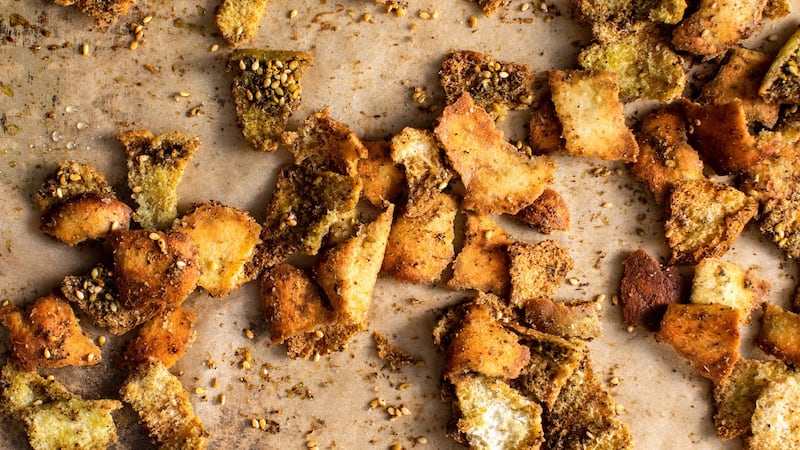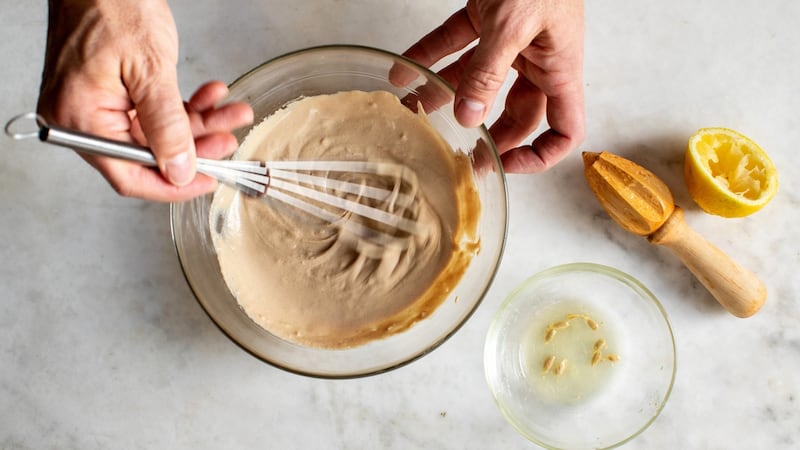In the process of making sure that bread, one of the most popular but also most perishable staples, doesn’t end up in the trash heap, cuisines the world over have used every tool at their disposal to find delicious recycling options.
The famous Irish and British love of desserts, to mention an example close to my heart, has given us bread-and-butter pudding (a pillow of warmth and steamy comfort), apple charlotte and summer pudding (semispheres of sweet soaked bread enveloping cooked seasonal fruit) and treacle tart (a tart filled with molasses and breadcrumbs). For many, dairy, fruit and a spoonful of sugar help a slice of white bread go down in a particularly delightful way, especially when there’s an extra jug of fresh custard in the vicinity.
In southern Europe, on the other hand, yesterday’s bread doesn’t come into its own bloated with sweetened milk or cream but, rather, upon sucking up considerable amounts of olive oil, vinegar and the juice of a fresh tomato . . . or three. Spanish pan con tomate (bread rubbed with tomato, drizzled with olive oil and sprinkled of salt) and Italian pappa al pomodoro (a Tuscan soup) and panzanella (a chopped salad) are the more recognisable dishes among many.


In the Middle East, the equivalent of panzanella is fattoush, a salad peppered with fried pieces of flatbread called khubz. The name “fattoush” comes from the Arabic verb “fatt”, which means to break up or crush, referring to the pieces of broken bread in the salad. The word is also the origin of an even more exciting Arabic dish using stale flatbread, and that is fatteh.
Fatteh is difficult to define because there are countless regional versions. What they all have in common, though, is the layering of distinct elements, one of which is bread, on to a platter. In vegetarian variations like mine, the lamb is left out. I also chose to go a little less traditional and place the bread on top, rather than on the bottom, to keep it more crispy.
Other traditional versions might include yogurt or tahini. Fattet djaj, for instance, has bread in it, shredded chicken, whole chickpeas, broth, a layer of yogurt sauce and a topping of pine nuts. In Gaza, a thin flatbread called saj or makouk is dipped in stock, which is often loaded with garlic, lemon and chillis, and topped with freshly cooked white rice and toasted nuts. It is then finished off with cooked chicken or other meats.

The list of ingredients that could go into a fatteh – from aubergine, to broad beans, to tomatoes, to different pulses, meat or fish – can be as lengthy as your imagination allows. Just as long as there’s enough delicious juice to soak up, an old piece of bread could be the best excuse you’ll ever have for a little rummage around your kitchen cupboard or fridge in pursuit of a seriously multilayered feast.
Chickpea and herb fatteh
Total time: 1½ hours, plus at least eight hours’ soaking
Serves 6
For the salad
350g dried chickpeas
2½tsp baking soda (bicarbonate of soda)
Salt and black pepper
1 round white or wholewheat pita, pocket opened up, roughly torn into small 2cm-3cm pieces
75ml olive oil
1tbsp za'atar
30g roughly chopped fresh coriander leaves and tender stems
30g roughly chopped fresh parsley leaves and tender stems
30g roughly chopped fresh chives
2½ tablespoons fresh lemon juice
2 garlic cloves, crushed using a garlic press
1 tsp cumin seeds, toasted, then roughly crushed
For the tahini sauce
80g tahini
1½tbsp fresh lemon juice
1 garlic clove, crushed using a garlic press
For the chilli oil
2½tbsp olive oil
½tsp red pepper flakes
¼tsp sweet paprika
Salt and black pepper
Method
1. Place the dried chickpeas and 1½ tsp baking soda in a large bowl. Top with enough cold water to cover by about 3cm, and let soak at room temperature for at least 8 hours or up to overnight.
2. Heat the oven to 190 degrees Celsius.
3. Drain the chickpeas well and add them to a large saucepan along with the remaining 1 tsp baking soda. Add 1.5 litres of water. Bring to a simmer over medium-high heat, then lower the heat to medium and let cook until chickpeas are soft but retain a slight bite, 30 to 35 minutes. (The cook time can vary greatly depending on your chickpeas, so check them at the 20-minute mark to determine how long you need.)
4. Add 1¼ tsp of salt and continue cooking until the chickpeas are super tender, 5 to 10 minutes more. Use a slotted spoon to set aside 100g strained cooked chickpeas. Keep the rest warm on a low heat until ready to serve.
5. While the chickpeas are cooking, prepare the toppings: Toss the pita with 2 tablespoons oil, the za’atar, ¼ tsp salt and a good grind of pepper, and spread out on a parchment-lined baking sheet. Bake until golden and crisp, tossing halfway through, about 12 minutes. Set aside to cool.
6. Make the tahini sauce: In a medium bowl, whisk the tahini, lemon juice and garlic with 70ml water and ¼ tsp salt until smooth and pourable. The tahini sauce will thicken as it sits.
7. Make the chilli oil: Add the oil and red pepper flakes to a small frying pan. Heat over medium until gently bubbling and fragrant, about 4 minutes, then add the paprika and remove from heat. Set aside.
8. When ready to serve, add the reserved 100g chickpeas to a food processor along with the fresh herbs, 2½ tbsp lemon juice, the garlic, cumin, ¼ tsp of salt, a good grind of pepper and the remaining 3 tbsp of oil. Blitz until smooth, then transfer to a large mixing bowl.
9. Drain the warm chickpeas using a sieve set over a bowl. Add the chickpeas and 170ml of their liquid to the herb mixture, mixing well to combine. You want the chickpeas to be well coated and the whole mixture to be saucy (but not overly wet), so add a couple more tablespoons of chickpea liquid if you wish (discard the remaining).
10. Transfer to a large platter with a lip. Drizzle lightly with some of the tahini sauce, then all of the chilli oil. Sprinkle with half of the pita and serve warm, with the extra tahini and toasted pita alongside. – New York Times

















